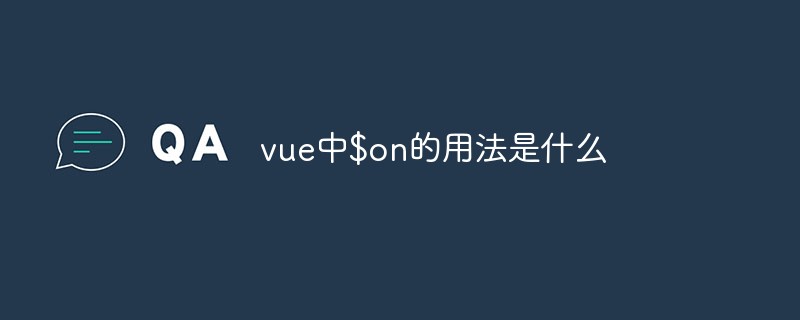What is the usage of $on in vue
In vue, "$on" is used to listen to custom events on the current instance. The event can be triggered by "vm.$emit". The callback function will receive all additional parameters passed in to the event triggering function. The syntax is "vm.$on(event, callback)".

The operating environment of this article: Windows 10 system, Vue version 2.9.6, DELL G3 computer.
What is the usage of $on in vue
Use $on(eventName) in vue to listen for events
$on(eventName) to listen for custom events on the current instance. Events can be triggered by vm.$emit. The callback function receives any additional parameters passed into the event triggering function.
vm.$on( event, callback )
Parameters:
{string | Array} event (Array is only supported in 2.2.0) {Function} callback
Instance 1 Single event on this page
<template>
<section>
<h1>left</h1>
<el-button type="primary" @click="isClick">点击</el-button>
</section>
</template>
<script>
export default {
methods: {
isClick() {
this.$emit('isLeft', '点击事件!');
}
},
mounted() {
this.$on('isLeft', (val) => {
console.log(val);
});
}
}
</script>The above code is through the click event of the button, then this.$emit passes the event, and then this.$on captures the event of this page
Example 2 Multiple events of this page
<template>
<section>
<h1>left</h1>
<el-button type="primary" @click="isClick">点击</el-button>
<el-button type="primary" @click="isClickOther">点击</el-button>
</section>
</template>
<script>
export default {
methods: {
isClick() {
this.$emit('isLeft', '点击事件!');
},
isClickOther() {
this.$emit('isRight', ['点击1', '点击2']);
}
},
mounted() {
this.$on('isLeft', (val) => {
console.log(val);
});
this.$on('isRight', (...val) => {
console.log(val);
});
this.$on(['isLeft', 'isRight'], () => {
console.log(666);
});
}
}
</script>The above examples are two click events on this page. You can listen to two events at the same time, and you can also pass multiple parameters at the same time
[Related recommendations: "vue.js tutorial" 】
The above is the detailed content of What is the usage of $on in vue. For more information, please follow other related articles on the PHP Chinese website!

Hot AI Tools

Undresser.AI Undress
AI-powered app for creating realistic nude photos

AI Clothes Remover
Online AI tool for removing clothes from photos.

Undress AI Tool
Undress images for free

Clothoff.io
AI clothes remover

AI Hentai Generator
Generate AI Hentai for free.

Hot Article

Hot Tools

Notepad++7.3.1
Easy-to-use and free code editor

SublimeText3 Chinese version
Chinese version, very easy to use

Zend Studio 13.0.1
Powerful PHP integrated development environment

Dreamweaver CS6
Visual web development tools

SublimeText3 Mac version
God-level code editing software (SublimeText3)

Hot Topics
 How to disable the change event in vue
May 09, 2024 pm 07:21 PM
How to disable the change event in vue
May 09, 2024 pm 07:21 PM
In Vue, the change event can be disabled in the following five ways: use the .disabled modifier to set the disabled element attribute using the v-on directive and preventDefault using the methods attribute and disableChange using the v-bind directive and :disabled
 Adaptation of Java framework and front-end Vue framework
Jun 01, 2024 pm 09:55 PM
Adaptation of Java framework and front-end Vue framework
Jun 01, 2024 pm 09:55 PM
The Java framework and Vue front-end adaptation implement communication through the middle layer (such as SpringBoot), and convert the back-end API into a JSON format that Vue can recognize. Adaptation methods include: using the Axios library to send requests to the backend and using the VueResource plug-in to send simplified API requests.
 What does async mean in vue
May 09, 2024 pm 07:03 PM
What does async mean in vue
May 09, 2024 pm 07:03 PM
Vue's async modifier is used to create asynchronous components or methods to achieve dynamic loading of components and execution of asynchronous operations to avoid blocking the main thread.
 The function of render function in vue
May 09, 2024 pm 07:06 PM
The function of render function in vue
May 09, 2024 pm 07:06 PM
The render function in Vue.js is responsible for converting component data into virtual DOM, which can improve performance, enable templating, and support cross-platform. Specific functions include: 1. Generating virtual DOM; 2. Improving performance; 3. Implementing templates; 4. Supporting cross-platform.
 How to use v-show in vue
May 09, 2024 pm 07:18 PM
How to use v-show in vue
May 09, 2024 pm 07:18 PM
The v-show directive is used to dynamically hide or show elements in Vue.js. Its usage is as follows: The syntax of the v-show directive: v-show="booleanExpression", booleanExpression is a Boolean expression that determines whether the element is displayed. The difference with v-if: v-show only hides/shows elements through the CSS display property, which optimizes performance; while v-if conditionally renders elements and recreates them after destruction.
 How to use elementui for render function in vue
May 09, 2024 pm 07:09 PM
How to use elementui for render function in vue
May 09, 2024 pm 07:09 PM
The render function is used to create the virtual DOM in a Vue.js application. In Element UI, you can integrate Element UI components into the render function by rendering the component directly, using JSX syntax, or using scopedSlots. When integrating, you need to import the Element UI library, set properties in kebab-case mode, and use scopedSlots to render slot content (if the component has slots).
 Nuxt.js: a practical guide
Oct 09, 2024 am 10:13 AM
Nuxt.js: a practical guide
Oct 09, 2024 am 10:13 AM
Nuxt is an opinionated Vue framework that makes it easier to build high-performance full-stack applications. It handles most of the complex configuration involved in routing, handling asynchronous data, middleware, and others. An opinionated director
 From PHP to Go or Front-end? The suggestions and confusions of reality from experienced people
Apr 01, 2025 pm 02:12 PM
From PHP to Go or Front-end? The suggestions and confusions of reality from experienced people
Apr 01, 2025 pm 02:12 PM
Confusion and the cause of choosing from PHP to Go Recently, I accidentally learned about the salary of colleagues in other positions such as Android and Embedded C in the company, and found that they are more...






